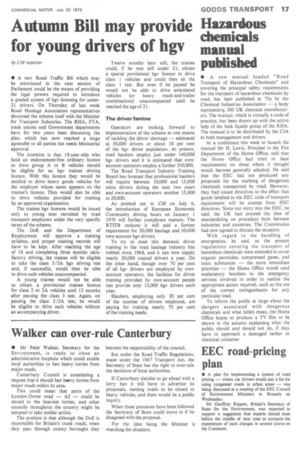by CM reporter • A new Road Traffic Bill which
Page 19

If you've noticed an error in this article please click here to report it so we can fix it.
may be introduced in the next session of Parliament could be the means of providing the legal powers required to introduce a graded system of hgv licensing for under21 drivers. On Thursday of last week Road Haulage Association representatives discussed the scheme itself with the Minister for Transport Industries. The RHA, FTA, trade unions and Government departments have for two years been discussing the plan, which has now reached a stage agreeable to all parties but needs Ministerial approval.
The intention is that 18-year-olds who hold an endorsement-free ordinary licence to drive group A or B vehicles should be eligible for an hgv trainee driving licence. With this licence they would be entitled to drive heavy goods vehicles for the employer whose name appears on the trainee's licence. They would also be able to drive vehicles provided for training by an approved organization.
The trainee hgv licences would be issued only to young men recruited by road transport employers under the very specific terms of the scheme.
The DoE and the Department of Employment will approve a training syllabus, and proper training records will have to be kept. After reaching the age of 18 and completing three months satisfactory driving, the trainee will be eligible to take the class 3/3A hgv driving test and, if successful, would then be able to drive such vehicles unaccompanied.
A young trainee would not be able to obtain a provisional trainee licence for class 2 or 2A vehicles until 12 months after passing the class 3 test. Again, on passing the class 2 /2A test, he would be eligible to drive such vehicles without an accompanying driver. Twelve months later still, the trainee could, if he was still under 21, obtain a special provisional hgv licence to drive class 1 vehicles and could then sit the class 1 test. But even if he passed he would not be able to drive articulated vehicles (or heavy truck-and-trailer combinations) unaccompanied until he reached the age of 21.
The driver famine Operators are looking forward to implementation of the scheme as one means of tackling the driver shortage — estimated at 50,000 drivers or about 10 per cent of the hgv driver population. At present, road hauliers employ just under 140,000 hgv drivers and it is estimated that ownaccount operators employ a further 350,000.
The Road Transport Industry Training Board has forecast that professional hauliers will require between 10,000 and 15,000 extra drivers during the next two years and own-account operators another 15,000 to 20,000.
As pointed out in CM on July 6, the introduction of European Economic Community driving hours on January 1 1976 will further complicate matters. The RTITB reckons it will add a further requirement for 20,000 haulage and 50,000 own-account hgv drivers.
To try td meet this demand, driver training in the road haulage industry has trebled since 1968, and it can now supply nearly 30,000 trained drivers a year On the other hand, though over 70 per cent of all hgv drivers are employed by ownaccount operators, the facilities for driver training provided by own-account people can provide only 15,000 hgv drivers each year.
Hauliers, employing only 30 per cent of the number of drivers employed, are paying for training nearly 70 per cent of the training needs.




































































































